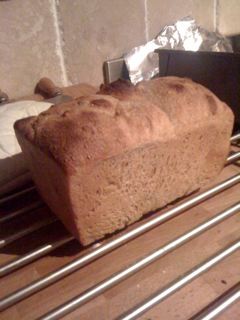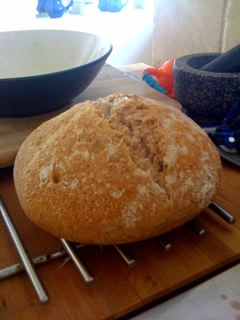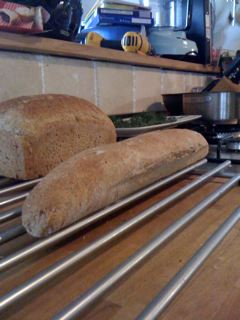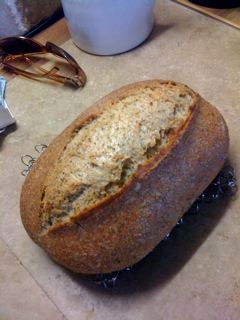Well, here it is! My first ever blog post. I have been thinking of starting a blog for awhile, if only to keep a catalog of the progress I've made in my bread making over the last year or so. It is difficult to quantify progress without something down on paper, as it were, so I hope this will be useful for myself and others, being able to look back through recipes and pictures for future reference. Anyway, I should give some background on my interest in bread baking. I am an American living in Britain, and was visiting home for a family wedding over a year ago. My mother had been experimenting in bread making, as she was trying to re-create my parents' favourite loaf from the local bakery. My mother has baked bread on and off for years, and I dimly recall some relatively dense and fairly dry bread-maker bread from my childhood (her hand baking is much better!). Anyway, she had recently gotten into the habit of making all the bread they ate (except for the occasional bakery purchase), and my husband I were really impressed with her bread. One morning we were there, she asked me to put the loaf in the oven for her after it had finished rising, and then because of my interest, she wrote down the recipe she used for her everyday bread. As soon as I got home, I got some baker's yeast, strong white and wholemeal flour, and I was busy baking. It took a number of attempts to get the rise right, figure out how to remove the clingfilm without deflating the loaf, etc, etc, but all in all every loaf I made tasted delicious. Over time, I really got the daily bread down pat, and started braiding loaves for fun, and adjusting different ingredients to get different textures.

(Sesame, Pumpkin and sunflower seed braided loaf)
Then, in the fall of last year, I came across info about creating your own starter at home, and eliminating the need for commercial yeast. Ever in search of the healthiest nutrition for my family, I decided to have a go at making sourdough. Although it seemed impossibly easy, I stirred up equal amounts of white and wholewheat flour and water, covered loosely, and left overnight. The next day, I discarded half and fed it again, re-covered and waited another day. By the third discard and feed, there was clear activity, and I was excited! I baked my first loaf from my brand new starter in a loaf tin, with great anticipation. I was thrilled to produce a nicely risen loaf with a few big bubbles on top and lots of lovely little bubbles on the crust!

Now, although this bread was delicious and a real triumph, I felt the need to make a yeasted bread for my husband who is less adventurous, and only likes icky cotton wool white bread for toast. *Sigh* It really does discourage one after all the effort put in. Nonetheless, our favourite winter lunch is soup and bread, so I was confident that a round loaf for soup dipping would be a hit, and a good way to slip in some wholesome nutrition. =) After much research, I started baking round loaves in a covered glass casserole dish and here was my first result:

Not the most amazing loaf, I know, but not bad considering it was a first attempt, and I had no clue about scoring, overnight retarding, stretching and folding, etc. With each loaf (despite the lop-sidedness due to dumping the proofed loaf into the hot bowl) I saw improvements...


I was even brave enough to attempt a freeform boule, and was very pleased with the result!

Next I tried a sourdough baguette and tin loaf, which were both excellent:

With the discovery of stretching and folding, overnight retarding and a firmer (lower hydration) dough, I managed my best loaf yet, a freeform poppyseed (can't remember the name of the shape):

Everything about this last loaf was an utter triumph for me. The fantastic opening of the slash, the shiny crackly crust, the soft and moist crumb, and the deliciously smooth and subtle sour taste. I cannot describe my joy in being able to create such a beautiful and delectable loaf, from nothing more than the usual baking drawer ingredients. What a joy and a privilege! Here's to many more loaves to come, and thank you to everyone on the Fresh Loaf from whom I've gotten tons of information which is helping me to continually improve and hone my baking skills!
- bakinbuff's Blog
- Log in or register to post comments
Welcome!
I had to smile at your first blog post- I have felt this way before. It is truly exciting to get a good loaf from your own oven.
Well done! I look forward to seeing what else you make!
cheers
I really love looking at pictures of loaves on this site, I think I'm addicted! Glad you enjoyed the post, and I will certainly keep posting my outcomes, as I've found other Fresh Loaf members' pictures and experiences so helpful.
Good looking bread and welcome to the blogging world, It's addicting so be carefull.
Dimitry Mishchuk
Healthy Living
I really enjoyed reading your new blog and following the journey you've made baking bread. Your pictures really do tell the story!
I know how you feel about the bread eater in your family - I have kids that don't like "things" in their bread. ( seeds, whole oatmeal, nuts -texture in general) At least they like whole wheat!
Happy Baking!
Marni
I am grateful that my children are unusually tolerant of all things healthful and nutritious, and I am so glad they like dipping bread in soup! My husband is my biggest critic (in the sense that he is hardest to please) but this is a great thing because I am constantly working on my cooking and baking to make it better...
I am interested in the fact that you are in England. I presume you have a regular European oven (unless you are using an Aga). I now live in Canada but have a European oven which is smaller than a North American one. I still bake bread using the same recipes I used in England. Recently I have been experimenting with American no-knead recipes using a stone and steam, but the oven temperatures given are far too high for my oven, particularly the pre-heat, and the top of the bread burns after just a few minutes. My question is, "What temperature do you use to bake your bread?" I have been reluctant to reduce the temperature as I believe the high temp. is needed to heat the stone and produce the steam.
Hi pollyanna!
I am in the UK, and I have a dual-fuel oven (gas on the stove top burners, electric oven, no fan). The max that the oven dial goes to is about 260C, and I usually preheat the oven at this temp or a little below with a stone on the rack and a large metal roasting pan on the stone. I preheat until the light turns off (which means the oven has reached the right temperature), plop the risen scored dough (in a parchment paper sling) on the stone and cover with the roasting pan. The pan traps moisture from the dough and gives the bread a crunchier crust than I ever achieved with steam, plus the bread doesn't really start browning until I remove the roasting pan after 20 minutes, at which point I turn the oven down to 190C for the last 10-20 minutes (depending on the size of the loaf). I would suggest since you already bake on a stone that you preheat a stainless steel bowl, foil baking tray, or other covering (or you could try baking in a dutch oven, I would love to buy one at some point). If you don't want to use a cover and you're happy with steam, I'd suggest popping a piece of tin foil over the bread when it has browned to the colour you want. I do this with my yeasted sandwich loaves as my husband is somewhat of a burned food-phobe, and grew up on icky white tesco bread. =) It's handy for controlling the colour of your loaf exactly without changing the baking time. Hope that is helpful!
Hi Bakinbuff,
Thanks so much for this. I usually tent my loaves with foil if they are getting too brown but the NK bread has been browning far too early in the baking. Your oven seems similar to mine and the temperatures you give are what are recommended in my stove recipe book. These are the temperatures I usually use for baking 'regular' bread so I shall try keeping to those for the NK. I like your idea of covering the dough and not using steam. I'll let you know how my next batch turns out. (I've discounted buying a dutch oven - far too expensive!) However, I must admit, my family really love my yeasted wholemeal sandwich bread which I have been making for decades and, after a period of experimenting, I usually go back to that.
How far up/down the oven are you baking your loaves? I tend to have the rack on the second to lowest notch, well away from the heating element. I will be fascinated to hear how your loaves differ when covered with something solid instead of steaming them... I know what you mean about dutch oven being expensive, I was very jealous that my sister was given one by her mother in law for Christmas, she had picked it up at a thrift store and her husband sand blasted it to get rid of the rust. It has spikes inside the lid so condensation that gathers drips back down (self-basting). I wish I could find cool stuff like that in thrift stores over here!
Like you, I usually bake my bread on the second lowest rack. With the NK I've been putting it on my roasting rack (this is a solid rack with a 'wire' rack that fits inside) so I can put the stone on the 'wire' rack with the water for the steam in the solid rack). I put that on the bottom notch, but the bread still browns too quickly with the temperatures usually given with NK bread. I'll try the lower temperature, with the bread covered, on the second notch and see what happens. The birds are getting fat on the 'rejects'.
The two things I miss about U.K. are the countryside (we lived in the Lake District) and the Kitchen Shops. As Canada has such a small population compared to U.K. and U.S., we don't have the variety of goods that are available in these countries and I love - useful! - kitchen gadgets.
Do you always use a stone? Would you like to share your recipe for Wholewheat sandwich bread?
I'd love to visit the Lake District, I have heard that it is incredibly beautiful. Hopefully we'll manage a camping trip up there sometime!
I'd love to share my recipe! It is very simple, and makes a lovely loaf.
I add 1 - 1.5 tsp instant yeast to 1 cup of warm water, with a dash of sugar, stir with a fork and leave to sit for about 10 minutes. In a large bowl I mix together:
1.5 Cups of wholewheat flour (I grind it fresh with a hand grinder)
1.5 Cups of strong white bread flour
1 tsp salt
1 TBSP olive oil
1 TBSP Honey
1/4 Cup of mixed seeds (sunflower, pumpkin and sesame seeds)
And when the yeast has blossomed nicely, I pour it over the flour mixture and mix with a sturdy plastic spatula until it begins to come together. Then I turn it out and knead it for 5-10 minutes, until very smooth and elastic (depending on the ww to white ratio of flour, more or less water might be needed, I never measure very carefully, just add a little more flour or water as needed). I oil the bowl used to mix the flour and pop the kneaded bread into it and cover with clingfilm, leave in a warm place until doubled, then turn out and shape into either a "log" that fits my bread tin or cut it up into sections and braid it together. Once the dough is risen nicely above the bread tin I bake for 10 minutes at 220C, then turn down to 190 and bake another 20-25 minutes (I cover with foil after 10 minutes or so at 190C as my husband doesn't like it too brown). I try to keep the wholewheat as at least half the amount of flour if I'm going to use it to make sandwiches for the children, because they don't eat all that much and I try to be sure that their meals are reasonably nutritious. However, I don't see any harm in having a decent amount of white flour in the mix to give it a nice fluffy texture, particularly since we eat more sourdough than yeasted bread, generally. If I were to make a 100% wholewheat loaf, no one in this house would want to eat it!
I use the proportions in that recipe for my basic dough and tweak it for interest by changing the seeds (sometimes I just use poppyseeds, I love them!), or adding herbs and making baguettes for garlic bread, etc.
I have a granite tile that I use as my baking stone, and I leave it in the oven all the time. My theory is that whatever I'm cooking is going to get a better cook with the stone soaking up and concentrating the heat evenly. (Not very technical terms there, but hopefully you know what I mean!) =) If you are concerned about burning, you could consider using a lower temperature after the first initial 20 minutes at a high temperature, and bake the loaf a little longer than you would have otherwise. I noticed a lot of recipes on this forum which give 250 or 260C for the initial 20 minutes, then 220C for the final 15 or 20, but in my oven I can guarantee my bread would burn uncovered at 220C, and especially the bottom of the bread sitting on the stone. I found that my bread bottoms were burning baked directly on the stone, so I now put the shaped dough on parchment (easier for transferring safely and quickly into the oven too) and to get a nice brown on the bottom, I take the parchment out when I remove the cover after the first 20 minutes. (This is of course for sourdoughs, which I don't usually bake in a tin). Hope you can fix your problem with burning!
Thank you so much for sharing your recipe. It is almost the same as what I use except I usually use raw sugar instead of honey. I also use 2 to 1 ratio of flour (more wholewheat, so I add some gluten). I have experimented with changing the liquid from water to milk, beer, potato water etc. but haven't noticed any significant change. I also add a spoonful of malt. I used to use malted flour in England but can't find it here.
Once again, "Thank you" and Happy Baking!
One other thing occurred to me regarding your problem with burning bread, are you at very high altitude? If so, your temperatures shouldn't need to be as hot as mine, pretty much at sea level...
No. I live in pancake flat Ontario, right on the edge and level with Lake Ontario - a far cry from my beloved Lake District.
I have just taken my bread out of the oven, taking your advice about temperature, etc. and it looks and smells great. Covering it at the beginning certainly helped to control the colour of the crust. Still too hot to cut and taste!
I now want to try using a starter which I have never done, if anyone reading this, has advice and suggestions, I would love to hear them.
Do you have a starter or do want to start one? It is very easy (at least, it is if it works the first time!). To start mine I just mixed up equal amounts of flour and water (I used half white and half whole wheat flour), cover loosely and left for a day, threw out half and fed with equal amounts of flour and water the next day, and the same the next day. By the third day it was bubbling and smelling sour. Since then I've used it to bake my daily loaves, and just made the occasional yeasted loaf for toast/sandwich bread. The main thing to be aware of using a starter instead of instant yeast is that you need to plan ahead. I mix up the dough the day before baking, and because I bake pretty much every day, that means baking in the morning the loaf I prepared the day before. Generally, the longer the ferment the more flavour the loaf has, and the easiest way for me to work out a long ferment without over-proofing is to put the shaped dough in the fridge overnight (the first rise is usually from 4pm to 10pm or so, then I shape and leave in the fridge overnight). Anyway, there is loads of useful info on the Sourdough and Starters section of the forum which should help you get started!
Thanks for the tip about the Sourdough Starter section. I'm afraid I haven't perused Fresh Loaf all that much yet but I'll check this out. I have never been what one would call a bread baker although I have been baking bread for decades. I was brought up in a home where we always had home made 'basic' tin loaves and have carried on using the same recipe during my married life, with a few 'tweaks' now and then. When we lived in England, we had a flour mill nearby which made and sold bread and I often supplemented my own bread with their artisan bread. It was hard to resist when the smell of baking bread wafted over the village. I really love bread but we eat very little these days (trying to control carbs!). There is only hubby and I at home now and we only eat bread for breakfast toast about three times a week and for the occasional sandwich. Although we eat homemade soup almost every day for lunch during the winter, we usually resist having bread with it. Now I have more time on my hands, I have the urge to do more baking. In my younger days, I used to bake lots and lots of cakes and pies but I don't want to go that route again. I cringe when I think about how we used to eat - all that sugar and fat. I think it was the result of not having enough to eat during the war that we went overboard when food became more available. So, it's back to bread. I have experimented lately with no-knead dough but I'm not impressed, plus I like kneading. So, hence the interest in using a starter so I can start experimenting instead of just baking boring sandwich loaves. A few basic questions. Do you keep the initial starter at room temp. or put in the fridge? Does it rise much, in other words, how big a container do I need as I never have much room in my fridge? Do I need to discard and add to the starter every day, even if I haven't used any? (As I won't be baking every day, I can see me forgetting to do this!) How much starter do I need for an average loaf? Thanks for your help.
I can imagine it must have been lovely to have a mill and bakery in your village, I would find it hard to resist too! Sadly our village doesn't even have a shop! We just about manage to have a post office any nothing else... Anyway, I keep my starter in the fridge, and when I make a loaf (which is generally every day) I take it out, add some flour and water to it, let it sit an hour or two, then use what I need for the loaf/loaves I am making and put the rest back in the fridge for my next bake. I suppose I could keep it on the counter as the kitchen is fairly cool and it is winter, but I find it is so low maintenance to keep it in the fridge and not have to think about it. I usually use 1 cup of the sponge (that is, the starter after it has been fed and sat covered for an hour or two) per 3 cups of flour or so (one loaf). So, if I am making a bigger batch of dough for two or more loaves, I might use 2 cups of sponge. I keep my starter fairly wet compared to some people, some people keep a firm starter, but I prefer a wet one (100% hydration) because I can get away with using it straight from the fridge if i want to skip the sponge step (in which case I feed what I don't use with flour and water and put it straight back in the fridge). When it is in the fridge it doesn't really expand much, I use a large plastic yogurt pot covered with a piece of kitchen roll with a rubber band to keep it on...
Thanks again. I'll get busy this weekend and, hopefully, make my first starter bread sometime next week.
Thanks again. I'll get busy this weekend and, hopefully, make my first starter bread sometime next week.
Also forgot to say, in case you haven't read it already somewhere else, once your starter is established and happy, you should be able to get away with feeding it once a week, if it is kept in the fridge.
Thanks again. I have spent the last few days browsing TFL and got totally confused. There is too-oo-oo much information out there. I got some helpful advice about starters when I posted but, in the end, I decided your version was the simplest so I began my starter this morning. I'll keep you informed how I get on. Decided I had to do something instead of watching it so made a date and walnut loaf - yummy AND FATTENING. Only allowing myself one slice a day!